Taming the devil
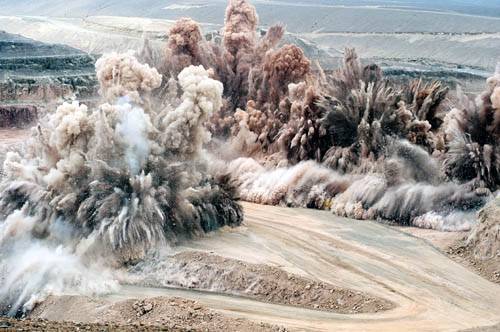 Truly in the explosive sits the devil, ready at any second to begin to destroy and break everything around. Keeping this product of hell in check and releasing it only when it is required is the main problem that chemists and pyrotechnics have to solve when creating and using explosives.
Truly in the explosive sits the devil, ready at any second to begin to destroy and break everything around. Keeping this product of hell in check and releasing it only when it is required is the main problem that chemists and pyrotechnics have to solve when creating and using explosives.For several centuries, the only kind of explosive that was used by man was black powder. With it, they threw nuclei at the enemy from cannons, filling explosive shells with them. Gunpowder was used in underground mines for the destruction of the walls of fortresses, for crushing rocks. However, gunpowder was not the only type of explosive known to man. For example, in 1799, the explosive mercury was discovered by Edward Howard. The famous melinite (aka picric acid, shimoza, trinitrophenol, liddite, perthite, picrite) was described by the English chemist Wulf as early as 1771, and already then his explosive properties were known.
Until the end of the first third of the XIX century, the powder fully met the needs of progress. But science and industry did not stand still, and soon it ceased to meet the requirements of the time because of its small capacity.
Explosive oil
And in 1846, the chemists proposed two new explosives - pyroxylin and nitroglycerin. In Turin, the Italian chemist Ascanio Sobrero discovered that it was enough to process glycerin with nitric acid (perform nitration) to form an oily transparent liquid — nitroglycerin. This can be done in the simplest conditions (it is more difficult to make black powder). In terms of explosive power, nitroglycerin is more than 20 times as large as black powder and in most parameters 4 – 5 is more powerful than TNT. Apart from a nuclear bomb, mankind has never invented more powerful explosives than nitroglycerin.
But the devil, who lives in nitroglycerin, turned out to be malicious and rebellious. It turned out that the sensitivity of this substance to external influences is only slightly inferior to explosive mercury. It can explode at the time of nitration, it can not be shaken, heated and cooled, put up in the sun. It may explode during storage. And if it is set on fire with a match, it can burn quite calmly ... But by the middle of the XIX century, the need for powerful explosives was so great that, despite numerous accidents, nitroglycerin was widely used in blasting operations.
The glory of curbing nitroglycerin belongs to Alfred Nobel. Who was this man riding the messenger of hell? It is well known that this is a Swedish scientist, engineer, inventor and entrepreneur. The connection between Nobel and Russia is much less well known. Do not be her, who knows if Nobel could invent dynamite?
Russian Swede
Alfred Nobel was born in Sweden in 1833, and already in 1837 his ruined father Emmanuel Nobel left Stockholm and left for Russia. Having received a good reward from the Russian government for the sea mine he invented, Emmanuel transports his family to Russia and opens a mechanical workshop in St. Petersburg in 1842. Significant military orders allow the company to quickly develop into a large, prosperous company (Fonderie et Atelier Mecanique Nobel et Fils).
The family’s cash allowance allowed Alfred to receive an excellent home education. The famous Russian chemist, full member of the Russian Academy of Sciences N.N. Zinin, who gave the painful Alfred chemistry lessons, instilled in him a love for this science. In the 16 years, Alfred helped his father in the development of sea mines, and then went to Paris, where he studied chemistry under the guidance of the famous scientist Peluz.
By the 1854, Zinin, after long attempts to tame nitroglycerin, is disappointed in him, but gives his former pupil the safety rules he developed: it was Zinin who determined the basic properties of nitroglycerin and the temperature limits in which he "behaves decently." During this period, Nobel moves closer to the artillery officer V.F. Petrushevsky, a great enthusiast of nitroglycerin, who made a lot in the field of studying methods of obtaining this explosive, and Russian chemists Jacobi and Vereskov.
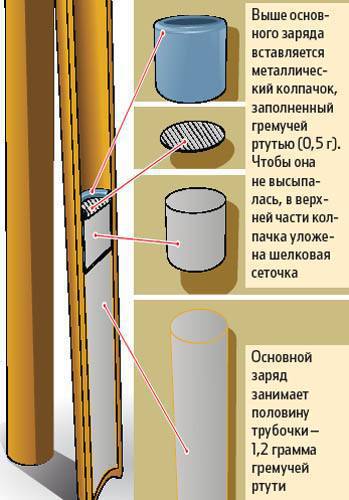 The detonator cap №8 is a copper tube, closed at one end and open at the other.
The detonator cap №8 is a copper tube, closed at one end and open at the other.Explosive nature
17 July 1866, a terrible explosion thunders in Peterhof - 20 pounds of nitroglycerin just obtained fly through the air. The result is a categorical prohibition of Emperor Alexander II to produce in Russia any work with hazardous liquids. But shortly before that, Petrushevsky suggested to Nobel that the cause of the nitroglycerin explosions was its decomposition with the formation of acidic unstable compounds, and mixing it with an acid neutralizing substance would make the explosive less dangerous. Petrushevsky did not invent dynamite, but at that moment was half a step away from it. It was he who suggested to Nobel the direction of further searches.
Despite the extreme danger, the need for powerful explosives was very high. In 1863, Nobel arrives in Stockholm, where he is fully committed to developing safe technologies for the production of nitroglycerin. He invents the injector for the continuous mixing of glycerin with acid in the nitration process, which dramatically reduces the risk of explosions in production. To increase safety, workers who followed the nitrification process, while sitting on one-legged stools - so as not to fall asleep and not let the chemical reaction out of control.
Despite the patent received by Nobel, the nitroglycerin devil was not afraid of his new owner. 3 September 1863, the Nobel enterprise in Gelenborg, takes off. Alfred's younger brother, 20-year-old Albert, is killed in the explosion. Nevertheless, in 1865, the Nobels managed to launch two new nitroglycerin production plants - in Sweden and Germany. Alfred "tours" in Europe and America, proving in public lectures the safety of nitroglycerin while observing the rules for handling it.
Nobel demonstrates his “exploding oil” in front of American businessmen, obtains a US patent and establishes his own company on the Atlantic coast of America. American powder manufacturer DuPont, sensing competition, is actively resisting the introduction of a new product. But here the enterprise in Germany takes off into the air, and almost simultaneously there are two large explosions in the mines in Sweden. In December, the nitroglycerin plant in the United States explodes and two vessels carrying nitroglycerin disappear without a trace in the depths of the ocean. Nobel’s name is cursed all over the world, in New York he is even asked to leave the hotel where he was staying and take with him all the samples of nitroglycerin. European countries one by one pass laws prohibiting the manufacture of nitroglycerin in their national territories.
Infusorial earth
The ban of nitroglycerin threatened Nobel with complete ruin. And then Alfred returns to his idea, which he began to work on as early as 1862, to neutralize the sensitivity of nitroglycerin when he was soaked in a porous substance. This path prompted him even in 1855, Petrushevsky, who was trying to impregnate black powder with nitroglycerin, hoping to increase the power of explosives.
In 1864, Nobel finds the right substance. Diatomaceous earth, also known as diatomite, infusorial earth and mountain flour, is formed during the precipitation of silicon shells of mollusks and some algae to the bottom of water bodies. Infusorial soil can be found in every lake, 90% of its volume falls on the pores that are capable of absorbing nitroglycerin eagerly.
The first experiments gave an excellent result. The mixture of nitroglycerin with diatomaceous earth was weaker than pure liquid by about a quarter (so much in the total amount of diatomaceous earth), but almost safe to use. Nobel gave this mixture, looks like peat, the name "dynamite" (from the Greek word "dinos" - power). After a series of rigorous tests of 7 in May of 1867, he patented dynamite in England, Sweden, and Germany. New explosive conquers Europe. Still, dynamite can be thrown, cut, shaken, it can be put in bags and crates, and it does not explode! But it works reliably when it is needed. The irony of fate - a year later, Petrushevsky completely independently mixes nitroglycerin with magnesia and receives explosives, later called “Russian dynamite”.
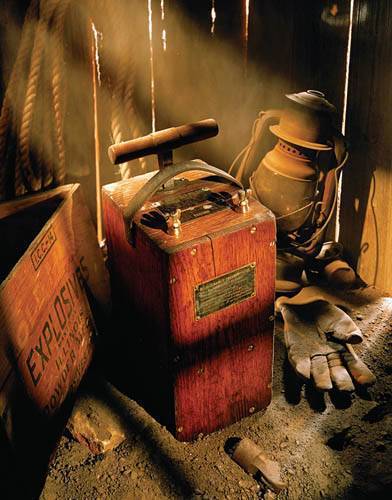 Dynamite Triumph
Dynamite TriumphThe end of the nineteenth century and the beginning of the twentieth - the period of the dynamite's triumph. It finds the widest application in the development of rocks, in tunneling, in mines. With its help, 80 tunnels, including the “Big Tunnel” - 15 km of solid rock were pierced during the construction of the railway through the St. Gotthard Pass. Dynamite pits were made for the supports of 324 bridges. Dynamic played a huge role in the construction of buildings of the century - the Panama Canal. 3000 tons of dynamite was used to dig up the New Croton reservoir system in New York (this work was completed in the 1890 year). Dynamite provides the laying of the Alpine tunnel and the Corinth Canal, removal of underwater rocks in the East River (New York), clearing the bed of the Danube ... Of course, dynamite began to be used in the Baku fields, where "Russian Rockefellers" hosted Alfred Nobel and Older brother.
Dynamite not only brought fame and glory to Alfred Nobel, but also made him a millionaire. If in the 1867 year his factory produced only 11 tons of dynamite, then after seven years the annual production at Nobel factories was already 3300 tons.
However, not all countries favored this explosive. For example, in France, military needs were forced to start producing dynamite in the spring of 1871, but the defeat in the Franco-Prussian war led to the fact that production was curtailed before 1875. In England, Abel’s lobbying for black powder led Parliament in 1869 to pass a law banning the manufacture, import, sale and transport of nitroglycerin and any other substance containing nitroglycerin within the UK. This law, under the pressure of a coal lobby in dire need of good explosives, was repealed only in 1893.
For seven years, Nobel built 17 plants in different countries of the world. By this time, more explosives were being produced in his enterprises than in the state powder plants of all countries of the world combined.
Nobel’s latest invention was the smokeless powder ballistic created by Alfred in collaboration with his personal secretary, the young Swedish chemist Ragnar Salman.
Alfred Nobel passed away at the age of 63 years 10 December 1896 of the year in San Remo at the zenith of glory and power. He owned enterprises 93, which in addition to dynamite produced nitric acid, glycerin, fertilizers, copper alloys, wire, cable, nitrocellulose, and all kinds of explosives and detonators.
Forgotten invention
It is believed that the dynamite was Alfred Nobel's finest hour. But experts believe that his main invention is not at all dynamite, but a small copper tubule. Primer-detonator was a real revolution in the explosive business, comparable only with the invention of the internal combustion engine in the field of mechanical engineering.
When black powder was used as explosives, there were no problems with initiating an explosion - it was enough to pour a track from the same powder to the charge and set it on fire. Later they began to use stopins (a thread impregnated with nitrate), then Bickford came up with his famous cord. When the fire reached the powder, the explosion was guaranteed. The situation changed with the advent of nitroglycerin, pyroxylin, melinit. These explosives, including even very sensitive nitroglycerin, flatly refused to explode from an open flame.
To initiate an explosion, it was best to use ... an explosion. Rattling mercury was already invented and used in percussion caps to ignite gunpowder in guns (capsular guns), and later in caps cartridge. In 1863, Alfred Nobel guessed to fill a copper tube open at one end with a thundering mercury in a fairly large number. This tube was placed in a charge of explosives, and Bickford fuse was inserted into its open end. The jet of flame of the ignited cord reliably ignited explosive mercury, sensitive to any external influence, and a small explosion was enough to explode nitroglycerin, and later - dynamite and other explosives.
Alfred Nobel developed a whole line of twelve blasting caps of various sizes and numbered them. The most suitable for most blasting operations was the 8 number. Over time, the detonator cap has improved, many varieties of it have appeared, but the Nobel number eight still has the same dimensions and design and is used in all countries of the world, unlike dynamite, which gradually and imperceptibly retreated into second roles. from the stage.
What is dynamite
The first variant developed by Nobel, “gurdinamit”, or dynamite No. 1, is 75% nitroglycerin and 25% kieselguhr. Nobel dynamite No.2 contains 25% nitroglycerin and 75% kieselguhr, dynamite No.3 contains 35% nitroglycerin and 65% kieselguhr. The last two are much weaker, but much safer to handle. Guerdinamites quickly disappeared from the scene. Nobel and other chemists began to create a variety of mixtures using nitroglycerin. Studies have led to the emergence of a new dynamite No. 3, consisting of 22% nitroglycerin, 66% nitrate and 12% coal. In Germany, a variety of dynamite called carbonite (26 – 30% nitroglycerin, 25 – 40% potassium nitrate, 25 – 40% rye flour) was developed.
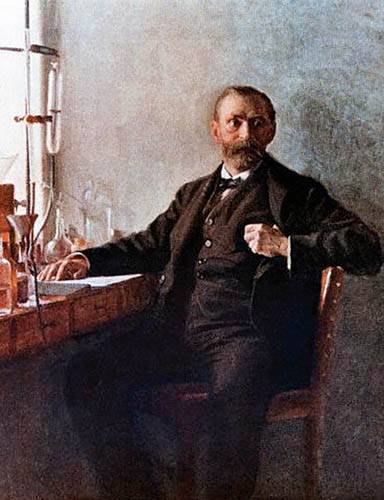
In the United States, Egbert Judson developed and patented a type of dynamite called Judson Powder, which contained potassium nitrate and sulfur, as well as anthracite and asphalt with the addition of only 5% pure nitroglycerin. In 1875, Nobel created the “explosive jelly”. A simple mixture of nitroglycerin (93%) and nitrocellulose (7%) Nobel gave the name "Explosive Jelly A". The gelatin of modification B of nitroglycerin contains all 82 – 88%, nitrocellulose 5 – 6%, cellulose 3% and sodium nitrate 5 – 6%. In the end, only the usual dynamites began to number about a dozen varieties, three gelled, four powder. Yes, and the names of dynamite has become a lot: tolamite, martinite, lignamite, tricelite, grizudininamite, gelatin dine, gelignite, grizutin.
Military application
For the first time, dynamite was used in the Franco-Prussian 1870 – 1871 war; Prussian sappers blew up French forts with dynamite. But the safety of dynamite turned out to be relative. The military instantly found out that when a bullet was shot through a bullet, it explodes, and burning in certain cases turns into an explosion. Dynamite requires qualified treatment. In the frozen state, it sharply increases its sensitivity, and when it thaws, nitroglycerin appears on its surface, showing all its flaws. Dynamite can not be stored for a long time (shooters say "dynamite is sweating"). Dynamite can not be pressed and even generally somehow condense. So, it is impossible to fill artillery shells, torpedoes and mines with dynamite: in peacetime they are stored for years and decades in boxes stacked in piles.
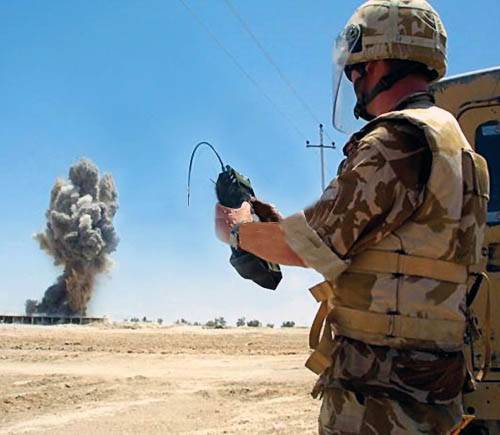
The military was more comfortable with pyroxylin (discovered by Shenbane in 1846), more chemically stable; its sensitivity could be adjusted by changing its humidity. TNT, who came to the scene at the beginning of the 20th century, turned out to be a pyroxylin gravedigger and finally forced the dynamite out of the military sphere. Today, dynamite finds very little use in the civil sectors of the national economy. It accounts for a maximum of 2% of the total amount of explosives consumed.
The US FM 5-250 Field Manual Explosives and Demolitions divides dynamites into standard (for blasting) and military. The latter is less powerful, but safer in storage and handling. However, one traditional name remained from dynamite in it - nitroglycerin is not included in its composition (the mixture consists of 75% hexogen, 15% trotyl, and 10% desensitizers and plasticizers).
Information